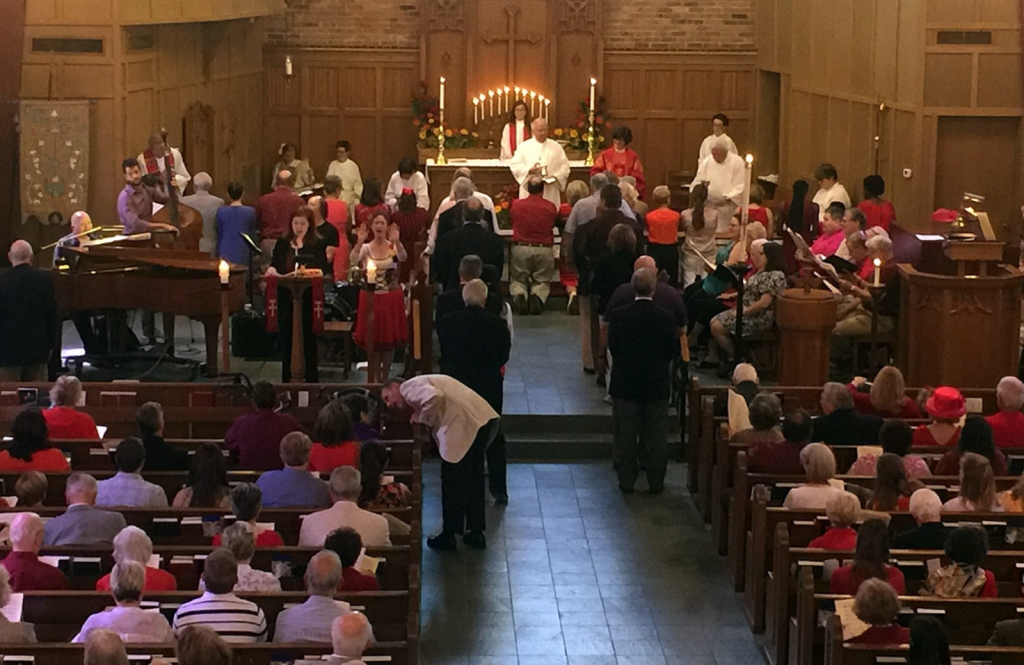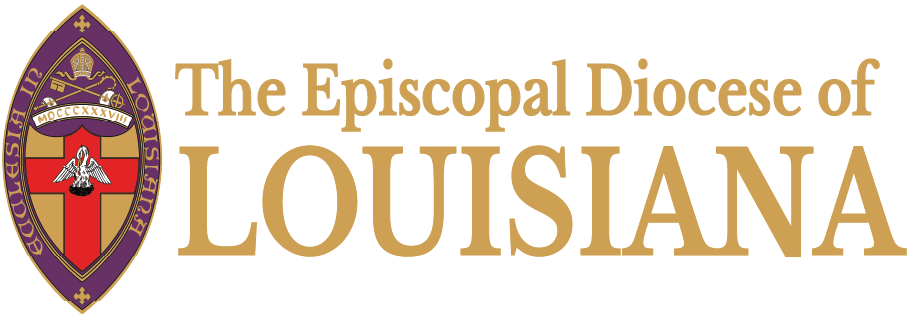September 2017 Churchwork reflection by the Rev. William Miller, rector of Christ Church, Covington

Pentecost Service at Christ Church, Covington, in 2017
Two years ago, Christ Church Covington made a very risky and unconventional decision. They hired me as rector! From the search committee to the vestry to the staff, the message I heard was consistent: “Things must change if we are going to grow and attract new people—and that’s why we called you!” Over the last two years, our average Sunday attendance has increased by thirty percent, and we had our largest adult confirmation class in history. We continue to see new visitors every Sunday, and there is a positive buzz about Christ Church Covington in the community.
We started with worship. It’s where everything must begin in the Episcopal Church. As my friend Bill Tully and parishioners of St. Bart’s in New York City (for years, the only Episcopal Church in NYC that was growing) used to tell others every chance they got: “Worship is at the heart of everything we do.” In the Episcopal Church, worship is what we (could) do best. It’s even how we, in our tradition, evangelize—we create an atmosphere in which people can fall in love with God. We “go to a lot of trouble” to create opportunities for people to experience this love in worship. Then we invite people, we welcome them (no, really, we do!), and we try our best to connect them. Services that work (well) are done with the highest standards (excellence in all we do), and with a deep awareness of our cultural context. We ask ourselves about our targeted audience, our demographic, our community, and how we might best reach them, not what best suits our particular tastes.
After a parish survey that allowed folks to voice their opinions about worship options, I took the results, made some decisions, and started changing things. We had four services for years, but they were basically all the same, apart from time. We immediately invested in worship. We distinguished each of the four services to broaden our appeal and speak to a more diverse population. We enhanced each service with quality music. For our 7:30 a.m. Rite One Chapel service, we added traditional piano music, leaning toward standard hymns and classical selections. We tweaked our 6:15 p.m. service to become a jazz vespers communion (yes, we made that up!), adding a jazz pianist and candles. We wanted to offer a high-quality traditional service. Through our research, we learned that the 9 a.m. slot would work best for most folks, so we transformed our 9 a.m. family service into a traditional service by enhancing the choir, adding section leaders, and investing in more consistent guest instrumentalists.
The one service we radically altered was the one offered at 11:15 a.m. We changed the time to 11:30 a.m. and made it a gospel/jazz/contemporary service (blended) with an excellent group of musicians (piano, bass, drums, and a female vocalist). We changed the liturgy to Enriching Our Worship. We were intentional about plugging in younger readers. We also made the service bulletin user-friendly by putting everything in there—hymns, readings, and responses—we do not require worshippers at this service to have six hands and an immediate knowledge of insider language and symbols!
Secondly, we paid a lot of attention to bridge events. That is, we began to think more intentionally (there’s that word again) about how to build bridges that might better connect us to folks in the community. We started a Jazz Weekend with concerts, community service events, and two jazz masses that pulled out all the stops. We knew it could not just be a simple concert series that happened to be held in our building—we had been doing that (quite well) for 25 years, and that had not really connected many people to the community of Christ in terms of membership or worship. The Jazz Weekend brought things to a whole new level.
We began to put more effort into events like our animal blessing. We held it at Bogue Falaya Park (next door to the church), hired a band, started providing fun food (Hot-diggity dogs), invited community-based animal advocacy groups to bring their critters, created a kissing booth for our most loveable pets, and had photo ops with Pierre the Pelican. Most importantly (this is true for all bridge events), we encouraged our parishioners to be out and about, meeting and mingling with visitors.
There were lots of other events that we have planned and executed that would certainly qualify as bridge events—we started a parade-viewing party at the rectory (it’s on the parade route). We also started a Theology on Tap Men’s Bible Study at a local pub. We began to ask ourselves which special worship services we might focus on in ways that would help people connect. We paid special attention to Passion Sunday and the story of the Passion, inviting actors to help us communicate the powerful drama that it is. During Holy Week, not only did we want to do all the traditional liturgies well, but we also added The Good Friday Project in which we invited performing artists to freely respond to the powerful themes of the day. We have not been afraid to experiment with liturgy or initiate whimsical themes for particular Sundays, encouraging participation and a sense of joy. Folks will be encouraged to wear their cowboy hats for Welcome Back Wili Sunday, and we will be the first church in the Diocese to offer a U2charist as well as a special presentation on “The Gospel According to U2” during the same week that they perform in New Orleans. Bridge events have definitively helped us cross-over and connect with our neighbors, and have truly encouraged and empowered them to connect and engage with us as well.
Thirdly, we focused on our Discovery Class and made sure we communicated how important it is, and how and why it is the vehicle by which one formally joins the church. We offered a lively mix of video, discussion and presentation, focusing on our Celtic roots, and even using the royal wedding as an example of Anglican worship at its finest. We offered alternatives for those who could not commit to Wednesday evenings by offering a Discovery Weekend as well. The result was our largest adult confirmation class in history, and for those who attended, a deeper understanding of what it means to be an Episcopalian and a member of Christ Church Covington.
In the midst of all these changes, we somehow managed to pull off a 1.75 million dollar Higher Ground Campaign to take care of 10 years of deferred maintenance and also fund several new ministry initiatives. Our growth has not been easy, and it has not been without challenges. We know that to sustain will require a true commitment to discipleship, stewardship, and evangelism. We are hopeful, and in the meantime, we have not forgotten to laugh, or to breathe.
 Christ Episcopal Church in Covington was established in 1846. The Rev. William Miller has served as rector since 2015. He is also the author of “The Gospel According to Sam” and “The Beer Drinkers Guide to God.”
Christ Episcopal Church in Covington was established in 1846. The Rev. William Miller has served as rector since 2015. He is also the author of “The Gospel According to Sam” and “The Beer Drinkers Guide to God.”
